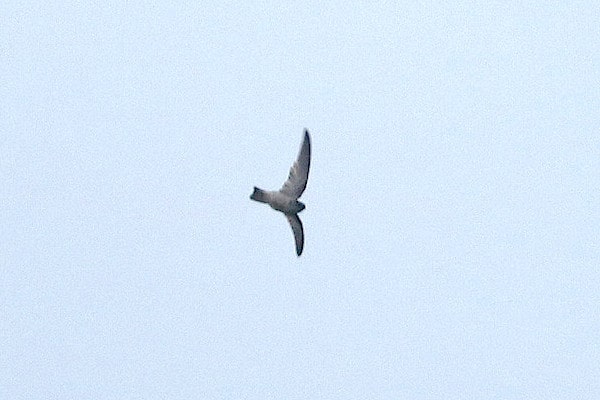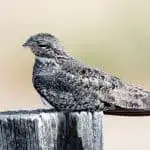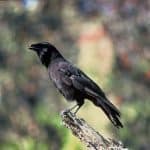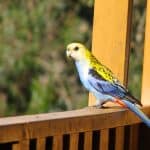Common Name: Mariana Swiftlet
Scientific Name: Aerodramus bartschi| Size | Diet | Range in Hawaii | Status in Hawaii |
|---|---|---|---|
| 3.5 in. - 4 in. | small flying insects | Unknown | Endangered |
The Mariana Swiftlet (Aerodramus bartschi) is swift species found in the Mariana Islands, including Guam, Saipan, and Aguiguan. This small, agile bird is known for its impressive aerial acrobatics and its ability to navigate through complex cave systems. Interestingly, this bird species was introduced to Hawaii in the early 1960s, and has been spotted on the island of O’ahu as non-breeding visitors and vagrants.
Mariana Swiftlet
Appearance
The Mariana Swiftlet is a small bird species known for its graceful and streamlined appearance. It measures approximately 3.5 to 4 inches (9 to 10 centimeters) in length, making it one of the smaller swiftlets.
The Mariana Swiftlet has gray plumage with a dark gray coloration on its upper parts and a slightly lighter shade on its underparts. It has a short, shallowly forked tail, which aids in its agile flight maneuvers. The wings are long and narrow, enabling swift and precise flight as it navigates through the air.
This species has a relatively large head in proportion to its smaller body, and its eyes are dark and round. The Mariana Swiftlet has a short, pointed bill, which it uses to catch insects while in flight. It also possesses strong, curved claws on its feet, allowing it to cling to vertical surfaces, such as the walls of caves or cliffs where it nests.

Diet
The diet of the Mariana Swiftlet primarily consists of small flying insects. As an aerial forager, it relies on its swift flight abilities to capture prey while in mid-air. It feeds on a variety of insects, including flies, termites, ants, and other small invertebrates that are abundant in its habitat.
Mariana Swiftlets have a unique feeding behavior known as aerial hawking. They dart and maneuver through the air, using their agile flight skills to chase and catch insects on the wing. Their short, pointed bills are well-suited for capturing and consuming their prey while in flight.
These swiftlets are also known to form feeding flocks, where multiple individuals gather in specific locations where insect densities are high. This behavior allows them to exploit concentrated food sources more efficiently.
Nesting
The Mariana Swiftlet is a colonial nester, meaning it forms large colonies where multiple individuals come together to build their nests in the same location. These colonies are typically found in natural caves, limestone crevices, or other sheltered areas that provide suitable conditions for nesting.
The nests of Mariana Swiftlets are constructed using saliva and plant materials. The birds use their sticky saliva as a binding agent to attach moss and other vegetation to the roof and walls of caves to create a cup-shaped structure.
The nests are often built on vertical surfaces, such as cave walls or cliffs, where they can be protected from predators and the elements. The female swiftlets lay a single white egg in each nest.
Both male and female birds take turns incubating the eggs, sharing the responsibility of caring for the offspring. The incubation period lasts for about 20 to 24 days, after which the eggs hatch, giving rise to small, naked chicks.
Once the chicks hatch, both parents continue to provide care and feed them. The young swiftlets grow rapidly, and within a few weeks, they develop feathers and become more independent. It takes several weeks for the chicks to fledge and leave the nest, during which time they undergo flight training and learn to navigate the surrounding environment.
The colonial nesting behavior of Mariana Swiftlets allows for increased protection against predators, as well as benefits in terms of social interaction and communication within the colony. The nests also serve as important breeding sites for the species, contributing to their overall population dynamics.
Behavior
The Mariana Swiftlet is highly adapted to an aerial lifestyle, spending most of its time in flight. These birds have remarkable flight agility and speed, allowing them to effortlessly navigate through the air while hunting for prey.
They are known for their communal nesting behavior. Mariana Swiftlets form large colonies, often numbering in the hundreds or even thousands of individuals, where they build their nests in close proximity to one another. These nesting sites are typically located in caves, limestone crevices, or other sheltered areas.
Within these colonies, the Mariana Swiftlets engage in social interactions. They communicate through a variety of vocalizations, including chirps, trills, and high-pitched calls. These vocalizations are used for various purposes, such as territory defense, mate attraction, and maintaining group cohesion.
The Mariana Swiftlet demonstrates biparental care, with both male and female individuals actively involved in incubating the eggs and raising the young. They take turns incubating the eggs, ensuring that they are kept warm and protected until they hatch. Once the chicks hatch, both parents contribute to feeding and caring for them until they fledge.
In addition to their foraging flights, Mariana Swiftlets engage in communal feeding behaviors. They often form feeding flocks, where multiple individuals gather in specific locations to exploit abundant insect food sources. This behavior allows them to increase their foraging efficiency and take advantage of concentrated prey.
Habitat
They primarily inhabits forested areas and limestone karst landscapes, where it finds suitable nesting and foraging sites.
These swiftlets are often found in close proximity to coastal regions, taking advantage of the diverse habitats available there. They can be seen in forests near cliffs, caves, and rocky outcrops, which provide the necessary shelter for their nesting colonies. Natural caves with vertical walls are particularly important, as they offer protected spaces for the construction of their nests.
The Mariana Swiftlet’s habitat preference is closely linked to the availability of suitable feeding grounds. They forage in open areas, including coastal zones, grasslands, and agricultural fields, where there is a high abundance of flying insects. These areas provide ample food resources for the swiftlets, supporting their energetic needs.
Range
These birds have a small natural range, found today mainly on Guam, Saipan and Aguiguan in the Northern Mariana Islands.
The Mariana Swiftlet is a non-native bird species in Hawaii, introduced to the state in the early 1960s on the island of O’ahu. Their presence in Hawaii adds to the diversity of bird species found in the state, but also raises concerns about the potential impacts on native species and ecosystems.
They persist to this day in a small area of O’ahu, and have not been seen on any other islands. Most sightings today occur along the ‘Aiea Ridge Trail.
Conservation Status
The Mariana Swiftlet is indeed listed as “Endangered” by the International Union for Conservation of Nature (IUCN). This designation signifies that the species is at a very high risk of extinction in the wild.
The primary reason for the endangered status of the Mariana Swiftlet is habitat loss and degradation. Deforestation, especially on the islands of Guam and Rota, has resulted in the loss of suitable nesting sites and foraging areas. Urban development, agriculture, and infrastructure projects have also contributed to the destruction and fragmentation of its habitat.
Interesting Facts
1. Aerial insectivores
These birds are specialized insectivores, relying on a diet primarily composed of small flying insects. They have adapted to catching prey while in flight, showcasing remarkable aerial hunting skills.
2. Vulnerable conservation status
The Mariana Swiftlet is listed as “Endangered” by the International Union for Conservation of Nature (IUCN). Habitat loss, invasive species, and other threats have contributed to the decline in its population.
3. Biparental care
Both male and female Mariana Swiftlets participate in incubating the eggs and raising the young. They take turns incubating the eggs and share the responsibilities of feeding and caring for the chicks.
4. Echolocation abilities
Like other swiftlet species, the Mariana Swiftlet uses echolocation to navigate through dark caves and locate its nest. This echolocation ability allows them to fly swiftly and accurately in the low-light conditions of their nesting sites.
5. Nocturnal nests
Unlike many other swiftlet species, the Mariana Swiftlet constructs its nests in dark, cave-like environments. This adaptation suggests that they may be more active during twilight hours or even at night.
Frequently Asked Questions
1. Can Mariana Swiftlets fly long distances?
While Mariana Swiftlets are capable of swift and agile flight, their range is limited to the Mariana Islands. They exhibit seasonal movement within the island chain but do not undertake long-distance migrations.
2. Are there any specific predators of the Mariana Swiftlet?
One of the primary predators of the Mariana Swiftlet is the invasive brown tree snake (Boiga irregularis), which preys on the birds and their eggs. This has had a significant impact on the population of swiftlets on Guam.
3. How long do Mariana Swiftlets typically live?
The exact lifespan of the Mariana Swiftlet in the wild is not well-documented. However, swiftlets in general are known to have relatively long lifespans compared to other bird species. Some swiftlet species have been recorded to live for more than 10 years.
4. Can Mariana Swiftlets swim or dive into water?
Mariana Swiftlets are not adapted for swimming or diving. They are aerial birds and spend most of their time in flight, using their specialized wings for agile maneuvering in the air.




